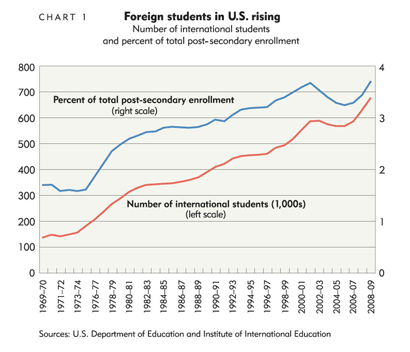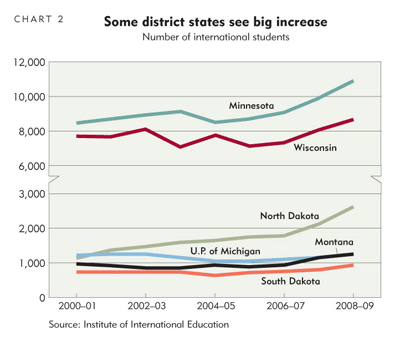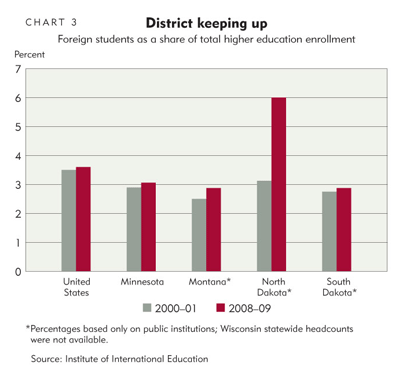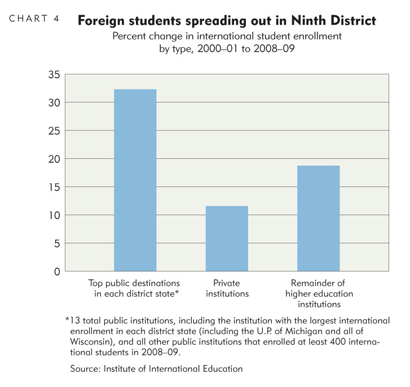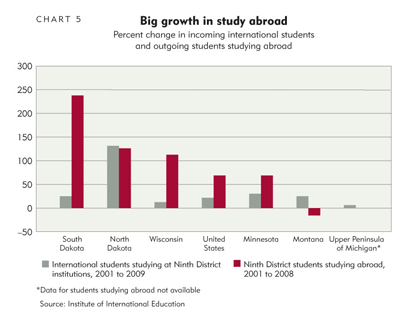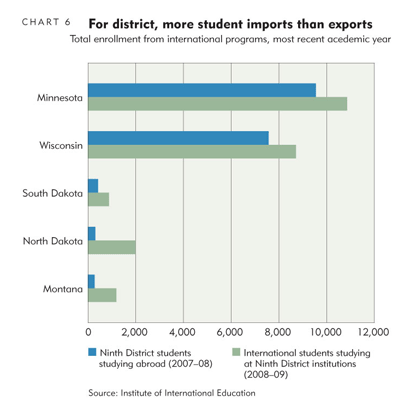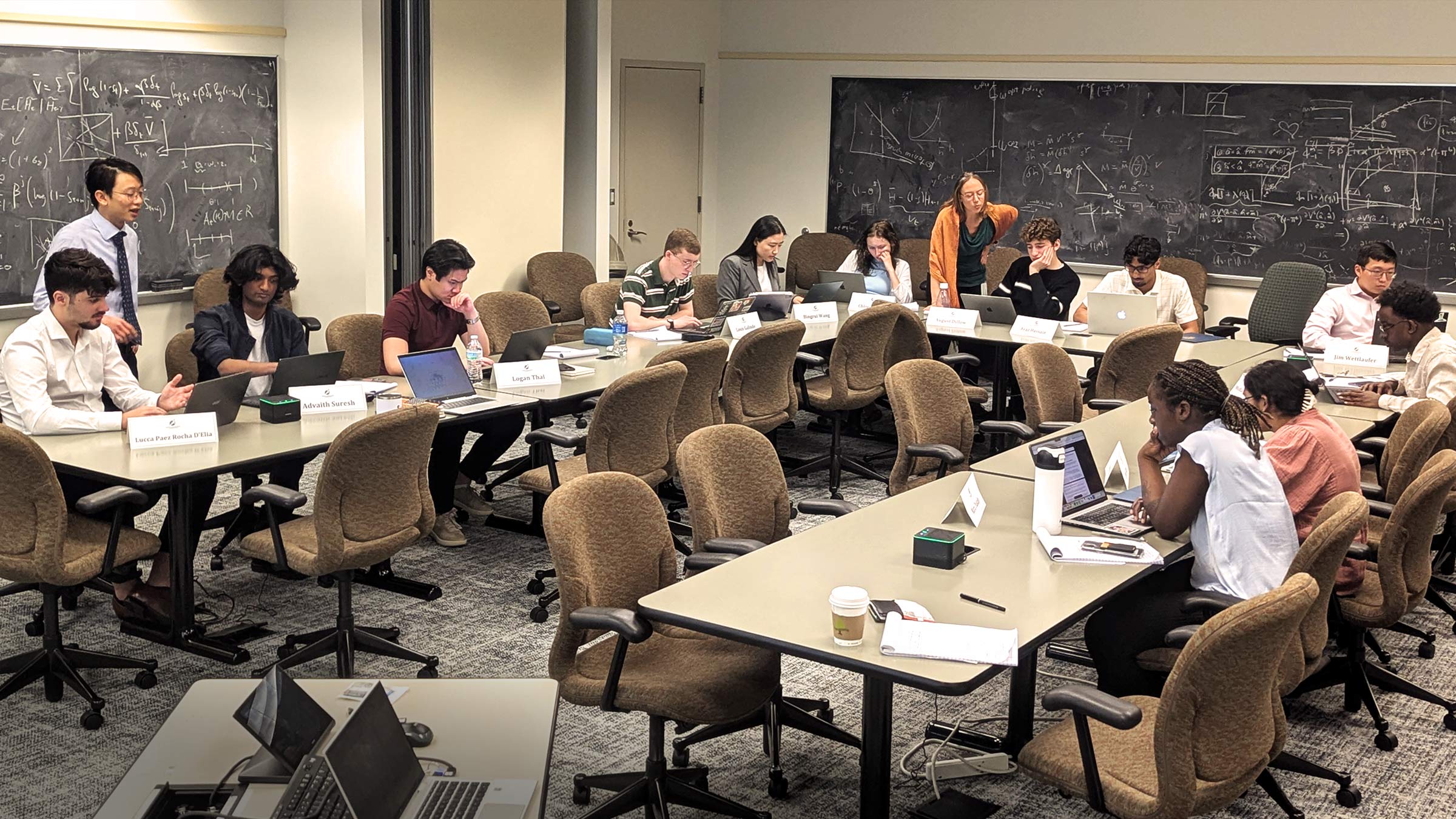Higher education in the district has a more international flavor than ever before. Despite a terrible start early in the decade, the number of foreign students has increased significantly at district colleges and universities during the past decade. Although growth was widespread in the region, a few instances stand out, including dramatic increases in North Dakota.
A countertrend is also afoot: The number of district students studying abroad has grown considerably faster this decade than the rate of incoming international students.
U.S. degree or bust
The U.S. higher education system has long been a magnet for foreign students. Their numbers have risen steadily (see Chart 1), and the international share of U.S. college enrollment climbed slowly from about 1.6 percent in the early 1970s to its current record high of 3.7 percent in 2008–09.
The only significant hiccup in this upward climb occurred earlier this decade. In the fall of 2003, foreign student enrollment declined for the first time since the early 1970s. Experts widely attribute the decline to the terrorist attacks of Sept. 11, 2001, which tightened national security and immigration policy and reportedly had a chilling effect on foreign student applications to American universities.
That hesitancy began to change course about mid-decade, and foreign student growth at the district and national levels resumed with gusto in subsequent years. Virtually all of the net growth in the district this decade has occurred since the 2006–07 academic year, according to data from the Institute of International Education (see Chart 2; historical figures for the Ninth District are unavailable before 2000–01, and 2008–09 enrollments are the most recent year available).
The increase in international students is due in part to the fact that colleges and universities “are more actively recruiting international students, especially undergraduate students,” according to Sam Gingerich, system vice president for academic affairs with the South Dakota Board of Regents. Fast-growing countries like China and India are straining to expand their higher education systems to accommodate a growing middle class, and “more families have the resources needed to look abroad,” he said. The motivations for such recruiting vary by campus, but the attraction of high-quality students, increased campus diversity, higher tuition rates (foreign students often pay thousands of dollars more in tuition than state residents) and other factors play a role.
The upward trend in foreign students runs parallel to enrollment growth across all of higher education, including a big recession-induced increase in the past few years (see more discussion of this overall trend in the November 2009 fedgazette). Direct comparisons of the two enrollment populations can be complicated because of a lack of precise data and different measuring sticks (headcount vs. full-time equivalent). But it appears that the increase of foreign students since 2000–01 outpaced that of total students in the district by roughly 6 to 8 percentage points, with foreign enrollments growing by almost 26 percent.
Although more recent comprehensive figures are not yet available, it appears that foreign enrollments continued to rise this past fall. The four campuses of the University of Minnesota, for example, saw their international freshman class grow by 13 percent last fall, compared with an overall freshman class that grew by about 6 percent, according to university figures.
Schools in the Midwest and Great Plains also appear to be closing some of the visibility gap with their peers nationwide. For starters, district growth of foreign students over the past decade was higher than the nation’s (25.8 percent and 22.6 percent, respectively). While the district’s ratio of foreign students to total enrollment is a bit lower than the national average, the gap narrowed (see Chart 3). North Dakota’s proportion of foreign student enrollment rose sharply, putting it head and shoulders above the national average.
Name that mascot
International students have spread themselves throughout the district, resulting in some apparent quirks. As you might expect, many foreign students hail from Canada. But in Montana, Saudi Arabia runs a very close second to Canada. And the tiny—and poor—country of Nepal is a top-five source of students for Minnesota and both Dakotas.
A modest handful of public universities (13) enroll almost two-thirds of foreign students in the district. This group saw foreign enrollment rise by 32 percent since 2000 (see Chart 4). However, the district’s largest—and most internationally visible—universities saw more modest growth: 23 percent for the University of Minnesota-Twin Cities and just 8 percent at the University of Wisconsin-Madison. Instead, international students were migrating to the likes of Dickinson State (N.D.), North Dakota State, Michigan Tech, Minnesota State-Moorhead and St. Cloud State (Minn.), all of which saw growth of at least 40 percent and sometimes much higher.
Not all district institutions have had the same success. Lake Superior State, in Sault Ste. Marie in the Upper Peninsula of Michigan, saw a 23 percent drop from 2000–01 to 2008–09; Marquette University, a private Jesuit school in Milwaukee and the largest private-college destination for international students in any district state, saw a similar decrease. Among large schools, Montana State joined UW-Madison with a single-digit increase over this period.
In fact, a fair portion of the district’s growth is due to the outlier performance of North Dakota; it is the only district state that did not experience a lull in the early part of the decade (see Chart 2), and its overall growth of 131 percent far outstripped that of the district and nation.
According to Michel Hillman, vice chancellor for academic and student affairs for the North Dakota University System, the state’s success is a byproduct of an effort to raise awareness of the opportunity and give individual campuses greater flexibility and incentive to market themselves internationally. There has been no top-down initiative from a central office—well, there was, but it was never funded, Hillman said. Instead, campuses like Dickinson State “made it a priority to recruit [international] students.”
The campus is home to a significant Mongolian population, Hillman said. Research universities tend to attract highly educated students from countries like China—the largest source of foreign students in the state—where research is a top priority.
In terms of marketing, universities typically partner with other organizations “with their feet already on the ground” in other countries, Hillman said. For example, if a state or federal trade office organizes an overseas trade expo, a campus (or several) might host a booth to attract potential students or their parents.
The United States is still the prime destination for most international students, though other countries are making inroads, Hillman said. While some might think North Dakota is a figurative and literal world away, “if you’re a parent in Nepal and don’t want to send your kid to a busy, urban school” and instead prefer a “smaller, more welcoming, safer environment, then North Dakota and South Dakota start to become pretty attractive.”
All abroad
A related trend in international students is those from the district who go abroad to further their education.
The number of district-based students studying in other countries has grown much more steeply than the inflow of foreign students, though the total number abroad is still about 25 percent lower (see Charts 5 and 6). Minnesota sends a much higher proportion of students abroad—2.7 percent of total enrollment, compared to less than 1 percent for Montana and North Dakota. The goals and aspirations of these two student populations in venturing abroad are quite different. American students typically use study-abroad programs to get some short-term international experience—a semester, oftentimes less—whereas foreign students come to U.S. institutions to earn a degree and are much more likely to remain in the United States afterward.
Gingerich, from South Dakota, said the state’s campuses have created more study-abroad programs in an effort to meet the student demand “for shorter-term experiences, primarily to enrich their college experience generally or, in some cases, their program of study. … Very few end up studying abroad for a full year, and even fewer graduate from a foreign institution.”
Ron Wirtz is a Minneapolis Fed regional outreach director. Ron tracks current business conditions, with a focus on employment and wages, construction, real estate, consumer spending, and tourism. In this role, he networks with businesses in the Bank’s six-state region and gives frequent speeches on economic conditions. Follow him on Twitter @RonWirtz.



